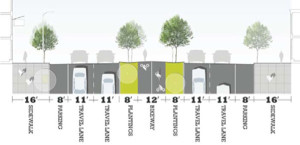
[vimeo 64098278]
The Spring Garden Street Greenway project has surpassed the urban planning phase and started the engineering stage. After a public engagement process the Pennsylvania Environment Council has decided on a preferred design for the greenway. If the project stays on schedule construction could begin as early as 2016.
“We’ve been meeting with elected officials and we are in fundraising mode,” said Pennsylvania Environment Council Project Manager Jeff Knowles.

Director of Sustainable Development at Pennsylvania Environment Council Spencer Finch said he believes the project appeals to a number of sources and will have many funding options. “We’re not asking any single funding source to pay for everything,” he said.
The William Penn Foundation, the Pennsylvania Department of Conservation and Natural Resources and the Delaware Valley Regional Planning Commission funded the project in the design stage.
The project also has support from the East Coast Greenway Alliance. The East Coast Greenway is a long-term project which aims to create a series of urban trails from Maine to Florida. Philadelphia is a missing portion of the greenway. Sarah Stuart, policy director at the Bicycle Coalition of Greater Philadelphia said she thinks the greenway would be a vital link.
“The greenway, if it’s implemented, will be the first time that the whole Philadelphia region has really made something like this for those who are using those modes of transportation,” she said.
Mid-Atlantic Trial Coordinator at the East Coast Greenway Alliance Andy Hamilton said 28 percent of the East Coast Greenway is completed with multi-use trails. However, he said some sections of the bike trails and paths still need to be improved.
“There is a way to go everywhere. Is it the final way, no,” he said.
The Spring Garden Street Greenway project will be a high quality, resource intensive bicycle and pedestrian facility. It will involve a lot of landscaping and includes a storm water management system.
“It’s a much bigger project, it’s much more expensive but that’s not a bad thing, it’s a good thing,” Stuart said. “Compared to building a street, highway, or off ramp it is still a very low cost.”

Finch said it is a big project for the city, but a small project looking from the Pennsylvania Department of Transportation’s perspective. “We’re not building Interstate 95 here,” he said.
The Pennsylvania Environment Council estimated the cost of the project to be $30.7 million. “This is bigger than just a trial, this is a transportation project,” Finch said.
The Spring Garden Street Greenway is also important to the city of Philadelphia because it will build a direct connection between the Delaware and Schuylkill rivers. “It is that one project that can link everything together, neighborhoods and rivers,” Finch said.
The greenway will not only reduce the time it takes for buses and cars to travel down the 2.2 mile stretch of Spring Garden Street, its implementation is also predicted to have a positive effect on businesses along the street and members of the community. “There is going to be such an amazing economic turn around,” Hamilton said.
In 2012, Real Estate Strategies, Inc. completed a market analysis for the project. The studies consisted of effects on the economy such as property values and the correlation between increased pedestrian and bicycle traffic and business sales. The consultant group also studied public health impacts. “We put together an impact analysis that will be used to make the case of investment and development of the greenway,” said Beth Beckett, a consultant for Real Estate Strategies, Inc.
Upon request of the consultant team’s conclusions, Knowles said he hopes to release the document to the public soon.
Rob Platten, secretary and board member of the Spring Garden Civic Association, said he believes the most important benefits of the greenway for the Spring Garden community will be health benefits.
“It can reduce crime, pollution and trash,” he said. “If the greenway goes through and it’s gorgeous, sustaining it is easier. It becomes the destination where people want to hang out.”
An obstacle for the execution of the project is funding. However, Finch said the synchronization of the funding is the more complicated challenge. The list of city agencies, organizations and institutions partnered with the Pennsylvania Environment Council for this project is lengthy. “We need to get everybody on the same page,” he said.

Finch said he expects the Philadelphia Water Department to make a commitment to the project. The water department has been working to improve stormwater management in Philadelphia by encouraging projects which build green stormwater infrastructure. The greenway’s proposed storm water utility will relieve combined sewer overflows where the volume of stormwater and wastewater is greater than the sewer system’s capacity. The overflow causes water to be released into the city’s streams before it is treated.
Platten said he sympathizes with the Pennsylvania Environment Council because it is trying to orchestrate many different city departments, citizens and civic associations. However, he also said city funding is prioritized and the project may not be affordable right now. “This isn’t saving anyone’s life or providing education,” he said.
Finch said he expects the project will follow the same timeline as a typical transportation project, maybe quicker. Stuart said she predicts the project could take as long as four to 10 years to complete.
“The reason it’s so hard to answer is that there are a lot of factors that have nothing to do with engineering or construction season, raising the money and the political will of elected officials,” Stuart said. “It’s going to take a major effort and it’s going to require elected officials to make it a high priority.”


Be the first to comment